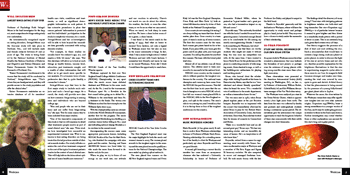Unprecedented Star Cluster
 A 14-year study by Wesleyan researchers has revealed a phenomenon that may indicate the forming of new planets or perhaps even the existence of young planets orbiting young sun-like stars more than 1,600 light years away.
A 14-year study by Wesleyan researchers has revealed a phenomenon that may indicate the forming of new planets or perhaps even the existence of young planets orbiting young sun-like stars more than 1,600 light years away.
The observations were presented at the American Astronomical Society (AAS) meeting in Washington, DC. on Jan. 11 by Professor of Astronomy William Herbst, Gabriel Roxby ’06, a Wesleyan undergraduate involved in the study, and Eric Williams, the systems manager of the Van Vleck observatory.
The Wesleyan team analyzed 500 stars in the Orion Nebula Cluster (ONC) which is approximately 1,600 light years from earth. The data from the stars were collected by faculty and graduate and undergraduate students during a continuous 14-year period. The observations gave the astronomers the unique opportunity to track the long-term behavior of these stars concurrently with their subtle changes over short timescales.
The findings detail the discovery of a large number of young T Tauri stars with intriguing patterns in brightness variation over both short and long timescales. One star discovered became of particular interest because it seemed to grow brighter then fainter in a remarkably steady pattern with a possible period of about 10 years. This is an extremely long cycle, given that it rotates every 1.18 days.
One theory suggests the presence of a disk of dust and rock orbiting the star. Such a circumstellar disk would have to contain a large clump, such as a planet or proto-planet, in order to obscure the light of the star at certain times and not others. Another possible explanation for the brightness fluctuations may be that the star is experiencing magnetic cycles akin to those seen in our Sun, where its magnetic field becomes stronger and weaker over time, causing the total area covered by sunspots to grow and shrink. Another theory is that the phenomenon is being caused by the presence of a young fully-formed gas-giant planet akin to Jupiter.
Whatever the cause, the observations by the Wesleyan researchers may offer significant insights into our own solar system’s origins. The star they studied bears a strong resemblance to a younger version of the Sun, and it may be undergoing processes similar to those in the Sun’s early history. Further investigation may reveal whether these or other explanations can account for this star’s long and regular period.

